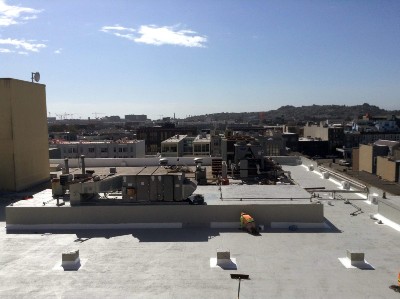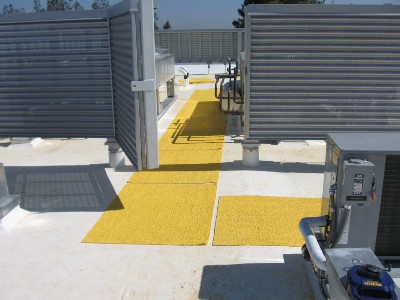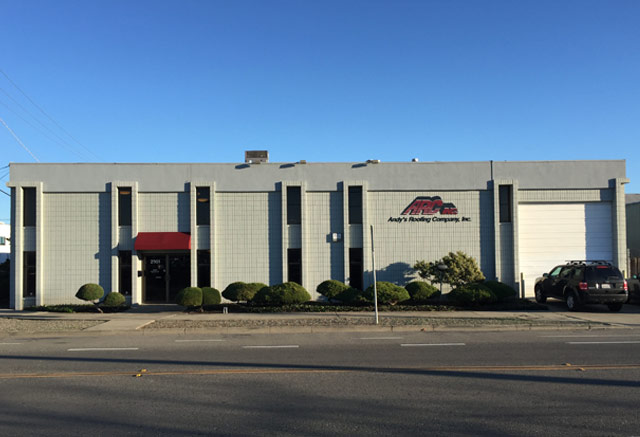Bay Area Low Slope Roofing Contractor
Andy’s Roofing specializes in the installation of low slope roof systems. We can expertly install tapered roof insulation systems beneath cold-applied and hot-applied Built-Up Roofing, as well as Single Ply Roofing. We are also certified to install Roof Coatings that can extend the life of your roof.
Andy’s Roofing is a certified installer of low slope roof systems for many of the roofing industry’s leading low slope roofing manufacturers, including GAF, JM, Versico, Garland, Carlisle, Firestone, Malarkey, Duro-Last, Fibertite, Hal Industries, and Flex.
Built-Up Roofing
Built-Up Roofing, sometimes referred to as a “tar and gravel” roof, is a tried and true roofing system that has been installed throughout the United States for over 100 years.
Single Ply Roofing
As the name would suggest, Single Ply Roofing systems are composed of a single sheet of roofing membrane that is either fully adhered or mechanically attached to the roof surface.
Roof Coating
A correctly installed roof coating application can stop leaks, extend the life of your existing roof, and increase the thermal efficiency of your building.
Commonly Asked Questions About Low Slope Roofing
What is considered a low slope roof?
A low slope roof is any roof with a slope between 3:12 and 6:12. A roof with a slope less than 3:12 is considered a flat roof, and a roof with a slope greater than 6:12 is considered a high slope roof.
The most typical low slope roofs you’ll find are industrial flat roofs, commercial low slope roofs, and residential low slope roofs. Low slope roofs are most commonly made of materials such as TPO, PVC, EPDM, or modified bitumen.
What are the major differences between a low slope roof and a steep roof?
A low slope roof is a type of roof slope with an angle of less than 12 degrees. A steep roof, on the other hand, is a roof slope with an angle of greater than 12 degrees. The two types of roofs differ greatly in their appearance, build, and installation.
Low slope roofs do not have as much of a steep slope and are therefore more simple to construct and less expensive. This is the major difference between the two types of roofs.
What type of roofing is best for a low pitch roof?
There are a variety of materials that are ideal for low slope roofs including TPO, PVC, EPDM, and modified bitumen.
TPO and PVC roofing are popular choices in the San Francisco Bay Area due to their superior solar reflectance (helping you save money), recycled content value, and effective protection against the elements.
How do you fix a low slope roof?
The most common problem with low slope roofing is a leak, but there are a few different causes that can lead to a leak. The key to fixing a low slope roof is knowing exactly where the leak is coming from, so you can get started on the repair right away.
The most common low slope roofing problems are caused by damaged sealant, cracked or punctured roofing membrane, and clogged drains paying attention to these signs of trouble, you’ll be able to fix the problem quickly.
To fix a low slope roof with a leak:
- Check the roof and identify where the leak is coming from: cracks, holes, seams, gaps
- Sweep away debris and water from the area
- Dry the area before treatment and level the area (remove any blisters)
- Patch the area with an appropriately compatible material
How do you waterproof a low pitch roof?
To successfully waterproof your low pitch roof, you’ll need to install a waterproof roof membrane. Unlike a high pitch roof, water will not simply slide off a low pitch roof; it must be drained.
The main issue is that low pitch roofs allow more water to collect on the roof, which is where leaks often occur. Incorrect installation of roofing membranes or improper flashing techniques are usually to blame for leaks, and the good news is that most of them are easy to fix.
The two most common waterproofing membranes are synthetic and natural. The membrane is always installed on top of the roof and is waterproofed and sealed to prevent water from penetrating the roofing.
Can I put shingles on a flat roof?
While shingles are widely available, they are not an ideal choice for a flat roof, as they have a tendency to allow for wind-driven rain when installed over a flat surface.
A better solution is to use a built-up roofing or single-ply roofing system to protect your commercial roof. Both built-up roofs and single ply roofs can better seal and protect your building’s flat roof from water intrusion, especially when paired with a tapered roof insulation system.
How often should a flat roof be coated?
Every 5 to 10 years, a coating should be applied to your roof to protect it from the effects of wind, rain, sun exposure and changing temperatures. However, the frequency of re-coating will depend on the characteristics of your particular roof.
In addition, the quality of the coating itself is also a major factor. If you are looking for a quality and professional roof coating company to work on your roof, look no further than Andy’s Roofing.
Does moss damage a flat roof?
Moss is a common issue in flat roofs, especially on the northern-facing walls and slopes, and it can dramatically reduce roof lifespan. Moss tends to thrive in shaded, wet areas, so it is most often found growing on roofs that are not properly maintained.
If you block the water by waterproofing your roof, the moss will die. Moss does not live on flat roofs with waterproofing and sealant because the roofing materials used in these areas prevent moisture.
Moss can also be prevented when flat roofs are made of materials such as PVC or TPO, also known as thermoplastic polyolefin, which are tough, synthetic materials. These membranes prevent any moss from growing on your roof.
Do flat roofs leak more?
Flat roofs are traditionally more susceptible to leaking than sloped roofs, because water can easily pool and sit right on the roof. Because of the lack of pitches, the water has nowhere to run off to and instead pools on the roof (also known as ponding water) and begins to seep in.
However, while flat roofs are more likely to leak, there are several ways to waterproof your flat roof, keep your flat roof in tip top shape, and avoid leaks.
What is a disadvantage of low slope roofs?
The biggest disadvantage is the cost. Because of the need for robust water protection, low sloped roofs are more expensive to install than other types. Furthermore, low sloped roofs are more difficult and more expensive to repair after they have sustained damage, and are more expensive to replace than other roof types.
What should I use on a low slope roof?
When it comes to a low slope roof (one that’s 3:12 or less in ratio), there are two main choices: built-up roofing and single-ply roofing. A popular choice among some building owners is a built-up roofing system.
Built-up roof systems are made by layering reinforced fiberglass roof membranes with layers of hot asphalt or cold adhesive. The final product is a thick and durable system that can be warranted for up to 30 years of service life. Single-ply roofing, on the other hand, is made up of just one layer, as the name implies.
Single ply roofing, such as TPO, PVC, or EPDM, is typically either adhered or fastened with screws and plates to a layer of fire-retardant coverboard, which can all be installed over a tapered roof insulation system that will assist in moving standing water off your roof.


Need a repair or re-roof estimate?
Fill out the form below and we’ll contact you to discuss your project and schedule an estimate.

Andy’s Roofing Co., Inc.
2161 Adams Avenue
San Leandro, CA 94577
Phone: 510-777-1100
Fax: 510-777-1102
